
Do you know the massive amount of energy the U.S. consumes? This video will explore our dependence on oil versus our dependence on renewable resources. [1:59]
- Subject:
- Science
- Material Type:
- Audio/Video
- Provider:
- The Atlantic
- Date Added:
- 08/01/2022

Do you know the massive amount of energy the U.S. consumes? This video will explore our dependence on oil versus our dependence on renewable resources. [1:59]

Biology 2e is designed to cover the scope and sequence requirements of a typical two-semester biology course for science majors. The text provides comprehensive coverage of foundational research and core biology concepts through an evolutionary lens. Biology includes rich features that engage students in scientific inquiry, highlight careers in the biological sciences, and offer everyday applications. The book also includes various types of practice and homework questions that help students understand—and apply—key concepts. The 2nd edition has been revised to incorporate clearer, more current, and more dynamic explanations, while maintaining the same organization as the first edition. Art and illustrations have been substantially improved, and the textbook features additional assessments and related resources.


By the end of this section, you will be able to do the following:
Describe the four major types of lipids
Explain the role of fats in storing energy
Differentiate between saturated and unsaturated fatty acids
Describe phospholipids and their role in cells
Define the basic structure of a steroid and some steroid functions
Explain how cholesterol helps maintain the plasma membrane's fluid nature

This resource from the CIA World Factbook provides a detailed fact sheet of Qatar. The content covers the country's geography, people, government, economy, communications, transportation, military, and transnational issues. It includes images of maps and the flag, as well as photos of the country.
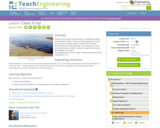
Students learn about a special branch of engineering called bioremediation, which is the use of living organisms to aid in the clean-up of pollutant spills. Students learn all about bioremediation and see examples of its importance. In the associated activity, students conduct an experiment and see bioremediation in action!
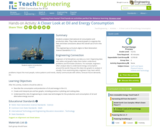
Students analyze international oil consumption and production data. They make several graphs to organize the data and draw conclusions about the overall use of oil in the world.
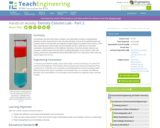
Concluding a two-part lab activity, students use triple balance beams and graduated cylinders to take measurements and calculate densities of several household liquids and compare them to the densities of irregularly shaped objects (as determined in Part 1). Then they create density columns with the three liquids and four solid items to test their calculations and predictions of the different densities. Once their density columns are complete, students determine the effect of adding detergent to the columns. After this activity, present the associated Density & Miscibility lesson for a discussion about why the column layers do not mix.
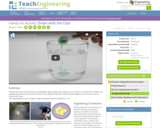
Students see how surface tension can enable light objects (paper clips, peppercorns) to float on an island of oil in water, and subsequently sink when the surface tension of the oil/water interface is reduced by the addition of a surfactant; such as ordinary dish soap.

A 2007 analysis of the challenges faced by Sudan in developing its key industry, oil.

View a timeline of Middle Eastern history, explore events through themes, and make connections through the use of big-picture questions such as "What's the appeal of religious militancy?"
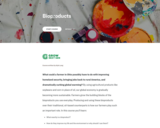
Grades 4-8. Course written by Kyle Lang. What could a farmer in Ohio possibly have to do with improving homeland security, bringing jobs back to rural America, and dramatically curbing global warming? By using agricultural products like soybeans and corn in place of oil, our global economy is gradually becoming more sustainable. Farmers grow the building blocks of the bioproducts you use everyday. Producing and using these bioproducts over their traditional, oil-based counterparts is how our farmers play such an important role. In this course you’ll learn: What exactly is a bioproduct? How do they improve my life and the environment or why should I use them? What bioproducts are available today? How do I get involved in the bioproducts industry?

Soap made from soybeans? Sunflowers? Olives? Plant oils have different “fatty acids” that determine the characteristics of your soap—is it creamy? bubbly? hard? soft? It is the oil in plants that makes different kinds of soap. Try this easy, melt-and-pour soap recipe to get started. This activity is one of several from a 4H Agriscience Biotechnology Series. This unit features 1 lesson and 1 file. Lessons are aligned to NGSS.
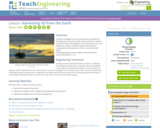
In this lesson, students investigate sources of fossil fuels, particularly oil. Students will learn how engineers and scientists look for oil by taking core samples from a model of the Earth. Also, students will explore and analyze oil consumption and production in the United States and around the world.
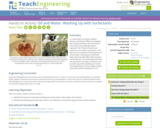
In a very hands-on activity, students observe and feel the differences between two cleaning methods, with and without hand soap, using coffee grounds to represent "dirt."Most of the dirt and bacteria on our hands is encased in a thin layer of oil, so because of the properties of oil and water, cleaning your hands with water alone has little effect when trying to remove the dirt. This activity demonstrates the importance of using a surfactant, such as hand soap, when washing your hands.
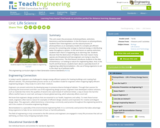
This unit covers the processes of photosynthesis, extinction, biomimicry and bioremediation. In the first lesson on photosynthesis, students learn how engineers use the natural process of photosynthesis as an exemplary model of a complex yet efficient process for converting solar energy to chemical energy or distributing water throughout a system. In the next lesson on species extinction, students learn that it is happening at an alarming rate. Students discover that the destruction of habitat is the main reason many species are threatened and how engineers are trying to stop this habitat destruction. The third lesson introduces students to the idea of biomimicry or looking to nature for engineering ideas. And, in the fourth and final lesson, students learn about a specialty branch of engineering called bioremediation the use of living organisms to aid in the clean up of pollutant spills.

This article provides background information related to natural resources of the poles, and renewable and non-renewable energy.
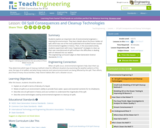
This lesson will allow students to explore an important role of environmental engineers: cleaning the environment. Students will learn details about the Exxon Valdez oil spill, which was one of the most publicized and studied environmental tragedies in history. In the accompanying activity, they will try many "engineered" strategies to clean up their own manufactured oil spill and learn the difficulties of dealing with oil released into our waters.
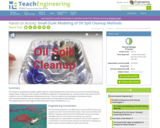
This hands-on experiment will provide students with an understanding of the issues that surround environmental cleanup. Students will create their own oil spill, try different methods for cleaning it up, and then discuss the merits of each method in terms of effectiveness (cleanliness) and cost. They will be asked to put themselves in the place of both an environmental engineer and an oil company owner who are responsible for the clean-up.